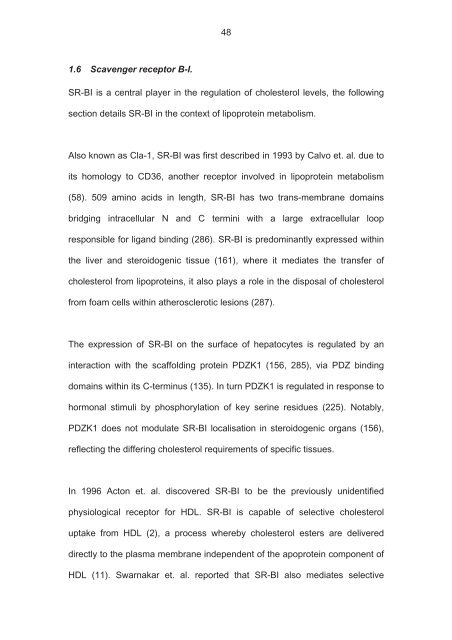The role of scavenger receptor BI in hepatitis - eTheses Repository ...
The role of scavenger receptor BI in hepatitis - eTheses Repository ...
The role of scavenger receptor BI in hepatitis - eTheses Repository ...
Create successful ePaper yourself
Turn your PDF publications into a flip-book with our unique Google optimized e-Paper software.
1.6 Scavenger <strong>receptor</strong> B-I.<br />
48<br />
SR-<strong>BI</strong> is a central player <strong>in</strong> the regulation <strong>of</strong> cholesterol levels, the follow<strong>in</strong>g<br />
section details SR-<strong>BI</strong> <strong>in</strong> the context <strong>of</strong> lipoprote<strong>in</strong> metabolism.<br />
Also known as Cla-1, SR-<strong>BI</strong> was first described <strong>in</strong> 1993 by Calvo et. al. due to<br />
its homology to CD36, another <strong>receptor</strong> <strong>in</strong>volved <strong>in</strong> lipoprote<strong>in</strong> metabolism<br />
(58). 509 am<strong>in</strong>o acids <strong>in</strong> length, SR-<strong>BI</strong> has two trans-membrane doma<strong>in</strong>s<br />
bridg<strong>in</strong>g <strong>in</strong>tracellular N and C term<strong>in</strong>i with a large extracellular loop<br />
responsible for ligand b<strong>in</strong>d<strong>in</strong>g (286). SR-<strong>BI</strong> is predom<strong>in</strong>antly expressed with<strong>in</strong><br />
the liver and steroidogenic tissue (161), where it mediates the transfer <strong>of</strong><br />
cholesterol from lipoprote<strong>in</strong>s, it also plays a <strong>role</strong> <strong>in</strong> the disposal <strong>of</strong> cholesterol<br />
from foam cells with<strong>in</strong> atherosclerotic lesions (287).<br />
<strong>The</strong> expression <strong>of</strong> SR-<strong>BI</strong> on the surface <strong>of</strong> hepatocytes is regulated by an<br />
<strong>in</strong>teraction with the scaffold<strong>in</strong>g prote<strong>in</strong> PDZK1 (156, 285), via PDZ b<strong>in</strong>d<strong>in</strong>g<br />
doma<strong>in</strong>s with<strong>in</strong> its C-term<strong>in</strong>us (135). In turn PDZK1 is regulated <strong>in</strong> response to<br />
hormonal stimuli by phosphorylation <strong>of</strong> key ser<strong>in</strong>e residues (225). Notably,<br />
PDZK1 does not modulate SR-<strong>BI</strong> localisation <strong>in</strong> steroidogenic organs (156),<br />
reflect<strong>in</strong>g the differ<strong>in</strong>g cholesterol requirements <strong>of</strong> specific tissues.<br />
In 1996 Acton et. al. discovered SR-<strong>BI</strong> to be the previously unidentified<br />
physiological <strong>receptor</strong> for HDL. SR-<strong>BI</strong> is capable <strong>of</strong> selective cholesterol<br />
uptake from HDL (2), a process whereby cholesterol esters are delivered<br />
directly to the plasma membrane <strong>in</strong>dependent <strong>of</strong> the apoprote<strong>in</strong> component <strong>of</strong><br />
HDL (11). Swarnakar et. al. reported that SR-<strong>BI</strong> also mediates selective

















